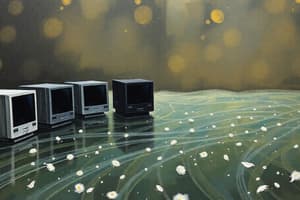Podcast
Questions and Answers
The third Generation of computers is characterized by the development of vacuum tubes.
The third Generation of computers is characterized by the development of vacuum tubes.
False (B)
Microcomputers became widely used in personal computing during the third Generation of computers.
Microcomputers became widely used in personal computing during the third Generation of computers.
False (B)
The fourth Generation of computers saw the introduction of networks and the development of the internet.
The fourth Generation of computers saw the introduction of networks and the development of the internet.
True (A)
Supercomputers are designed to perform billions of operations per second.
Supercomputers are designed to perform billions of operations per second.
Fifth Generation computers focus on developing devices capable of learning and understanding natural language.
Fifth Generation computers focus on developing devices capable of learning and understanding natural language.
The first generation of computers utilized transistors as their primary component.
The first generation of computers utilized transistors as their primary component.
During the second generation, the processing speed of computers increased to 1 million instructions per second.
During the second generation, the processing speed of computers increased to 1 million instructions per second.
The only programming language used in the first generation was assembly language.
The only programming language used in the first generation was assembly language.
Integrated circuits were introduced during the third generation of computers.
Integrated circuits were introduced during the third generation of computers.
The high-level programming language introduced during the second generation was called FORTRAN.
The high-level programming language introduced during the second generation was called FORTRAN.
Flashcards
Third Generation Computers
Third Generation Computers
Computers that used integrated circuits (ICs) for processing, leading to increased memory capacity, smaller size, and faster speeds. They introduced operating systems and made computers more accessible to a wider audience.
Integrated Circuit (IC)
Integrated Circuit (IC)
A small semiconductor chip that contains thousands of transistors, allowing for increased processing speed and efficiency in computers.
Fourth Generation Computers
Fourth Generation Computers
Computers defined by the development of the microprocessor, leading to personal computers (PCs), smaller sizes, and the emergence of the internet and GUI (Graphical User Interface).
Microprocessor
Microprocessor
Signup and view all the flashcards
Fifth Generation Computers
Fifth Generation Computers
Signup and view all the flashcards
Second Generation Computers
Second Generation Computers
Signup and view all the flashcards
Vacuum Tubes
Vacuum Tubes
Signup and view all the flashcards
Transistors
Transistors
Signup and view all the flashcards
Study Notes
Computer Generations
- First Generation (1946-1958):
- Computers used vacuum tubes and magnetic drums for processing.
- Processing speed was 1,000 instructions per second.
- Size: Mainframe only.
- Limited memory capacity.
- Expensive to operate due to heat generation.
- Used machine language (0s and 1s).
- Input: Punch cards and paper tape.
- Output: Printouts.
- Examples: UNIVAC (first commercial business computer), IBM 701.
Second Generation (1959-1964):
- Hardware:
- Transistors replaced vacuum tubes.
- Magnetic cores for memory.
- Increased memory capacity.
- Processing speed: 1 million instructions per second.
- Size: Mainframe only.
- More energy-efficient and reliable than the first generation.
- Software:
- Assembly language (easier to understand than machine language).
- High-level programming languages started appearing, though not mainstream.
- Examples of programming languages are introduced
- Input and Output:
- Input: Punch cards.
- Output: Printouts.
- Magnetic tape and discs for storage.
Third Generation (1965-1970):
-
Hardware:
- Integrated circuits (chips) for internal operations.
- Processing speed: 10 million instructions per second.
- Size: Mainframes and mini-computers.
- Increased memory capacity.
- Examples: IBM System 360, Burroughs B5000.
-
Software:
- Operating systems were developed which allowed multiple applications to run simultaneously.
-
Input and Output:
- Input: Keyboards.
- Output: Monitors.
-
Other developments:
- Increased accessibility and mass production of computers.
- Emergence of the software industry.
- Reduction in size and cost.
- Increased speed and reliability.
- Introduction of computer families.
Fourth Generation (1971-present):
- Hardware:
- Microprocessors: 100,000+ components on a chip.
- Processing speed: 100 million instructions per second.
- Size: Mainframes, mini-computers, and micro-computers.
- Greater portability.
- Software: -Development of microcomputers and supercomputers.
- Development of networks which eventually led to the internet.
- Introduction of user-friendly interfaces (GUI).
- Development of Large-scale integration (LSI) - circuits with thousands of components on a single chip.
- Example Computers: Apple II, TRS-80, IBM System 370, IBM PC, Motorola 6803-based computers.
Fifth Generation (Present and beyond):
- Focus: Artificial intelligence (AI).
- Goal: Develop devices that respond to natural language inputs, learn, and self-organize.
- Technology: Parallel processing, superconductors, quantum computation, and nanotechnology.
- Emerging applications: Voice recognition.
- Moore's Law: Increasing circuit capacity every 18 months.
- Impact on future computers: Radical changes in computer design are anticipated.
Studying That Suits You
Use AI to generate personalized quizzes and flashcards to suit your learning preferences.




